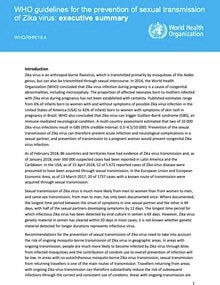WHO published interim guidelines on the prevention of sexual transmission of Zika virus in September 2016 (1), based on a limited amount of evidence under an emergency process during a public health emergency of international concern.
Zika virus is an arthropod-borne flavivirus, which is transmitted primarily by mosquitoes of the Aedes genus, but can also be transmitted through sexual intercourse. In 2016, the World Health Organization (WHO) concluded that Zika virus infection during pregnancy is a cause of congenital abnormalities, including microcephaly. The proportion of affected neonates born to mothers infected with Zika virus during pregnancy has not been established with certainty. Published estimates range from 6% of infants born to women with and without symptoms of possible Zika virus infection in the United States of America (USA) to 42% of infants born to women with symptoms of skin rash in pregnancy in Brazil. WHO also concluded that Zika virus can trigger Guillain-Barré syndrome (GBS), an immune-mediated neurological condition. A multi-country assessment estimated that two of 10 000 Zika virus infections result in GBS (95% credible Interval: 0.5–4.5/10 000). Prevention of the sexual transmission of Zika virus can therefore prevent acute infection and neurological complications in a sexual partner, and prevention of transmission to a pregnant woman would prevent congenital Zika virus infection.
|

